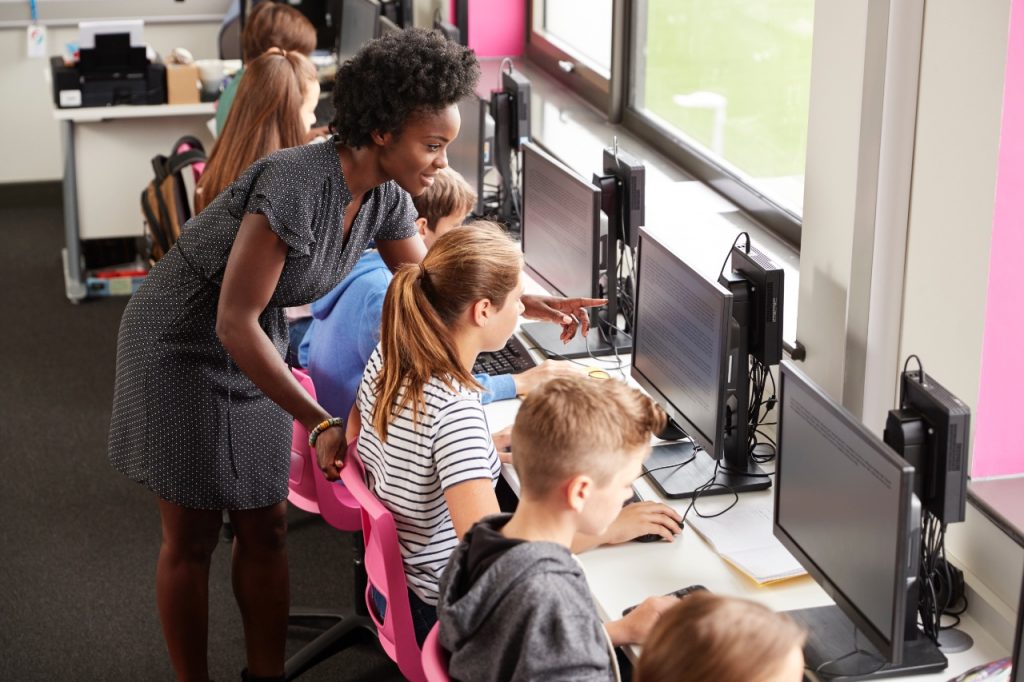This pandemic has brought a new model of learning, which is online for people. Today, from the time we get up in the morning to the time we sleep, we are surrounded by media like newspapers, radio, TV, and computers. So, getting tech-savvy and using information and communication tools is very important in the changing society. If we use and adopt ICT in schools, our education system can prosper, and the country would become a knowledge superpower. The three challenges that people face in using ICT tools are:
Access Equity Quality
Now, schools are taking the benefits of ICT to deliver knowledge and information to children. ICT has become a core in the teaching-learning process. It has replaced blackboards with whiteboards and implemented the usage of a digital smartboard for teaching. When teachers become tech-savvy and properly trained to use these tools, they deliver enhanced knowledge with high order thinking skills. Before moving further, let’s first understand what ICT is?
What is ICT in Education?
ICT stands for Information and Communications Technology. As the name suggests are tools that handle information and produce, store, and disseminate information. ICT comprises of both old and new tools. Old tools include radio, TV, Telephone. New tools comprise computers, satellites, the Internet, and wireless technology. It exists in multiple forms like audio, video, audio-visual, and texts. It refers to the latest technologies and a repository of simple audio-visual aids such as slides, radio, cassette, and film. According to Blurton, ICT is defined as “A diverse set of technologies, tools, and resources used to communicate, create, disseminate, store, and manage information.” These technologies include computers, the internet, radio, TV, etc. We can use information and communication technologies in the education for many reasons, but there are some practical problems in the implementation of ICT in primary education.
Why Introduce ICT in Schools?
Tools of technology like TV, Radio, Computers, the Internet, Mobile phones all play an important part in our lives. People use ICT to stay connected and become adaptable to it. ICT is an important part of our lives and has transformed it completely. According to Cross and Adam, the four basic factors that are responsible for introducing ICT in education are as follows: Social: Technology plays an important role in society. Students need to be made aware of technology and strive to become tech-savvy. Vocational: Many jobs nowadays are technology-oriented. Catalytic: Using technology tools as a great way to enhance the teaching-learning process. Pedagogical: Technology and ICT tools as a great way to enhance learning, flexibility, and efficiency in the process of disseminating knowledge.
ICT as A Current Thinker and Adapter
There are three ways by which ICT can be considered as an important tool in education. These are as follows:
ICT education
ICT education means using trained personnel who can meet the needs and deliver information effectively to society. The vision is to train people and to equip students with ICT skills and knowledge.
ICT-supported education
It is also known as multimedia education. Around the world, many institutes and universities use ICT tools for printed study materials. It includes broadcast media, like radio, TV, audio-visual aids, etc.
ICT-enabled education
ICT-enabled education means the content is disseminated through ICT tools. Here, ICT is considered as a medium required for the teaching-learning process.
Objectives of using ICT in Education
The objectives of ICT in education include:
Providing accessibility through online medium of education. Improving the quality of teaching, especially in remote areas. To increase transparency in the education system. To strengthen the policies, rules, and laws in the education system. To analyze the learning and participation of the students and measure its effectiveness. Measuring and evaluating students’ behavior, involvement, and retention in the learning process. To analyze students’ performance, placement, and application of knowledge.
The Importance of ICT in Education
The importance and role of ICT in education are as follows:
Online learning
ICT and its tools had led to the emergence of online learning. Through this, the teachers and the students are learning innovative ways in the education process. Online learning has gained popularity amidst the corona pandemic to ensure that the learning continues. ICTs have looked after that education reaches through it worldwide and even in remote areas. No matter where the students are, but it has ensured that every learner derives its benefits.
Accessible to all
ICT in education allows accessibility to all types of learners. All students can learn through the material provided. Even the special needs students can maximize the benefits through the usage of it. ICT has also covered issues like the “digital divide” and allows even less fortunate people to access the tools for their educational needs and enhance learning.
Higher-order thinking & skill developments
ICT promotes high order thinking and reasoning skills. These skills enabled the process of evaluation, planning, monitoring, controlling, reflecting, etc. To use ICT tools effectively, one must be able to explain and justify the solutions to the problems. For using ICTs, the students should be able to discuss, test, and evaluate the strategies and methods they use.
Better subject learning
The key role of ICT is to enhance subject learning and acquire skills. It promotes key learning in areas of literacy and numeracy.
Develops ICT literacy and capability
Literacy and capability are the 21st-century skills that are needed. One of the best ways to develop these is to equip the subject-matter with purposeful activities.
Encourages collaboration
ICT fosters collaboration as children work collectively. It also enhances communication skills as they discuss, talk, and learn together. All you need is a laptop, tablet, or desktop computer to understand it’s working. ICT tools open up the doors for developing language through fostering communication.
Motivates learning
ICT motivates children towards learning. Children learn better through the usage of technology. They get mesmerized with technology tools and get motivated to learn effectively in the classroom or at home.
Improves engagement and knowledge retention
With the inclusion of ICT in education and its tools, children get more engaged and show greater participation in learning. It is all because of technology. It has made learning fun-filled with creativity and games. It enhances learning in multiple ways. Because of it, the students learn better, leading to knowledge retention.
Effective differentiation instruction with technology
There are varied learners with distinct learning styles in this society. So, technology does the task of providing differentiated instruction to different learners.
A key part of the curriculum
As per the latest curriculum, ICT plays an important part in the education system. So, many governments across the globe have started using ICT as a major part of education and the curriculum.
The rise of the knowledge economy
We live in an economy that is a thirst for the production and dissemination of information properly. ICT pervades at all levels and sectors like health, education, environment, or production. So, its use is needed everywhere at all levels. Therefore, we cannot deny the fact that ICT is an important part of our lives. It fosters collaboration and connectivity around the world. Technology is ever-changing. It is likable due to certain features like growth, creativity, joy, fun, and consumption.
Importance of Students Engaging with ICT
Students should engage with ICT in order to:
To develop 21st-century skills like ICT Literacy and capability. To improve retention levels. Make them prepared for an integrated society that is taking advantage of the ICT developments. Adapt ICT tools as a lifelong partner.
Advantages of ICT in Education
Individualization of learning
It means that people learn as an individual and not as the same group. As learners are varied, ICTs provide flexibility so that learners learn according to their own pace.
Interactivity
Through this feature of ICT, learners can learn properly at any point. They do not need to follow a proper sequence. Learners can learn effectively through this feature.
More economical, the higher speed of delivery and wider reach
ICT tools are more economical, and the speed of delivering content is also high. Through ICTs, the number of learners increases, thereby reducing the overhead cost of investment.
Multiple teaching functions and diverse audiences
ICT involves multiple functions like diagnosing and solving problems for accessing information and knowledge about various contents. It can be useful in drills and practices also.
Uniform quality
ICTs act as a great equalizer by producing uniform quality content for the rich and the poor, the urban and rural people. It produces good quality content for all.
Facilitates cooperative learning
ICT facilitates cooperative learning by encouraging dialogue, discussions through a more participative classroom environment.
Act as a motivating tool
ICT tools act as a motivator and encourage children to enhance their learning. Children get fascinated with technology. Teachers should use their skills to arouse interest, fun, and creativity to learn in a better way.
Distance and climate insensitive
Regardless of the distance and climatic conditions, ICT tools provide access to all. These were some advantages of ICT in the education sector. Now let’s get an insight into certain disadvantages of ICT.
Disadvantages of ICT in Education
Its disadvantage depends upon the usage. They are as follows:
High Infrastructure and start-up costs
ICT tools involve high maintenance and start-up costs. The cost of hardware and software can also be very high. So, high costs act as a barrier to its accessibility.
Little attention towards individual differences to achieve economies of scale
Cost depends upon quantity. The higher the quantity, the lower the cost, and vice-versa. So, to keep the cost low, the content developed is uniform and of common quality. To keep the content common, the individual differences are not kept in mind. It creates a digital divide amongst the students. Those who are tech-savvy and familiarised with ICT tools learn better and faster than others who are not familiar with ICT tools.
Accessibility issue
This is the most common issue worldwide. Everyone does not have equal access. Some may receive great benefits, while others may not. The key accessibility factors include:
Timing of broadcast Electricity Poverty Illiteracy Time constraints Mobility
These factors act as a barrier to accessibility.
Difficulty in performance evaluation
ICTs enhance learning, which is usually multidimensional in nature with a long-term goal. Hence, it leads to difficulty in evaluating performances virtually compared to classroom evaluation, which is immediate.
Continuous training requirement
Technology is ever-changing, and so is the need to train the people. As many educators and teachers are not familiar with ICT tools, they may not provide upgraded knowledge through which learning hinders among the students. Therefore, it is essential to train all the people to involve in ICT.
Attitudinal change to understand the teaching and learning
In the world of diverse media and teaching processes, there arises a need to adapt to the differentiated teaching-learning process. The goal may shift from learning to the acquisition of skills of ICTs. In this way, there is a need for change in the attitudes and mindset of people.
Common Educational Applications of ICT
One device per child
If there is a 1:1 laptop per child, there might be issues like lower power consumption, a low-cost operating system, and special re-programming and mesh network functions. These issues for reducing costs still cannot fulfill the need to provide one laptop per child.
Tablets
Tablet is a small touch screen personal gadget that can be operated without a keyboard or mouse. It is one of the best interactive learning tools as you can download and use the necessary software for learning. The interactive learning apps promote high-order thinking and reasoning skills as a result students express their understanding in a better way.
Interactive whiteboards
It is possible to display, edit, drag, click, or copy the projected computer images through interactive whiteboards or smartboards. Users can take and save handwritten notes for future reference. It is used for whole-class instruction instead of student-centric. ICT can bring high student participation and engagement.
E-readers
Thousands of digitalized books can be stored on e-readers. Students find e-readers useful for independent reading. Its features include easy portability, long battery life, responsiveness to text, and the ability to define unknown text or words.
Flipped classrooms
Flipped classrooms involve multiple features like a lecture and practice through a computer anywhere. It involves computer-guided and interactive learning activities for a better understanding of the topic. The students’ viewpoint about the flipped classroom is mostly positive, but they prefer cooperative learning activities instead of attending lectures.
Featured ICT-related Projects and Activities in the Education Sector
The following projects of the Asian Development Bank are lighting up the path of education at different levels. Similar projects should be appreciated that promote ICT in education around the globe.
Secondary Education Sector Investment Program
The loan on this aims at developing effective, equitable, and high-quality education in the secondary education sector. Its result is the better use of information and communication technology for pedagogy. Its plan is to install 10 computers with the internet and its proper maintenance, equipment, and security in approximately 5000 schools.
Information and Communication Technology for better education services
It includes developing and implementing gender-inclusive ICT, identifying ICT hardware options, developing suitable applications, comprehensive evaluation of ICT access, ICT workshop to create awareness, etc.
Higher Education in the Pacific Investment Program
It aims to achieve equitable access to higher education in USP member countries, especially for women and pacific students. It is planning to provide new ICT equipment to remote campuses easily and quickly with reliable content.
Conclusion
ICT plays a significant role in the field of education. It helps teachers to adapt the tools and provide and disseminate effective knowledge to the students. It implemented the principle of life-long learning. ICT in schools effectively promotes the culture of learning by sharing experiences and information with others. It has developed technology literacy among students. It supports activities involving information. These activities include gathering, processing, storing, and disseminating information. ICT has proved and done wonders in the field of education. Editor: Vinay Prajapati


